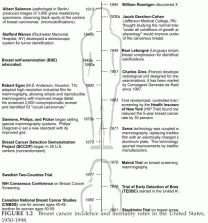Developing Technologies for the Early Detection of Breast Cancer
A wide range of factors must be considered at the various stages, including safety, accuracy, cost-effectiveness, and negative side effects.
 FIGURE 1.2 Breast cancer incidence and mortality rates in the United States, 1950-1998.
FIGURE 1.2 Breast cancer incidence and mortality rates in the United States, 1950-1998.
*Age-adjusted to the 1940 U.S. standard population. SOURCE: Health, United States 2000, National Center for Health Statistics, National Vital Statistics System, Centers for Disease Control and Prevention.
§Age-adjusted to the 1970 U.S. standard population. SOURCE: SEER Cancer Statistics Review, 1973-1996 (Ries et al., 1999). Numbers are calculated using cancer incidence rates from the regions of the U.S. included in the National Cancer Institute’s Surveillance, Epidemiology, and End Results (SEER) program and population data collected by the U.S. Bureau of the Census.
†Inset: Mortality data on a compressed scale to demonstrate the recent decrease. Between 1990 and 1998, mortality decreased by ~2%/year on average.
The level of evidence needed to establish efficacy, how effectiveness should be established, how costs should be measured, and how much evidence is needed before decisions about coverage are made-including offering and paying for screening-are all critical questions that need to be addressed. According to Edward Golub at the Pacific Center for Ethics and Applied Biology: “We are on the verge of an era of technological change in which the ability to do tests can determine whether we do them, which ones we do, and on whom they are done; it is crucial to understand the value and limits of [screening] tests, and how they fit into the goals of medicine. We are in danger of behaving as if all technological change is progress, and of confusing being swept along on the wave of changes with responsible exercise of the authority that society has given to the clinician in that which matters most to people, their health” (Golub, 1999, p. 14).
The purpose of the study presented in this report was to review breast cancer detection technologies in development and to examine the many steps in medical technology development as they specifically apply to methods for the early detection of breast cancer. The study committee was charged with ‘surveying existing technologies and identifying promising new technologies for early detection, assessing the technical and scientific opportunities.’ The committee was further charged with examining the ‘policies that influence the development, adoption, and use of technologies.’
###
Sharyl J. Nass, I. Craig Henderson, and Joyce C. Lashof
Committee on Technologies for the Early Detection of Breast Cancer
National Cancer Policy Board INSTITUTE OF MEDICINE and Division of Earth and Life Studies
NATIONAL RESEARCH COUNCIL